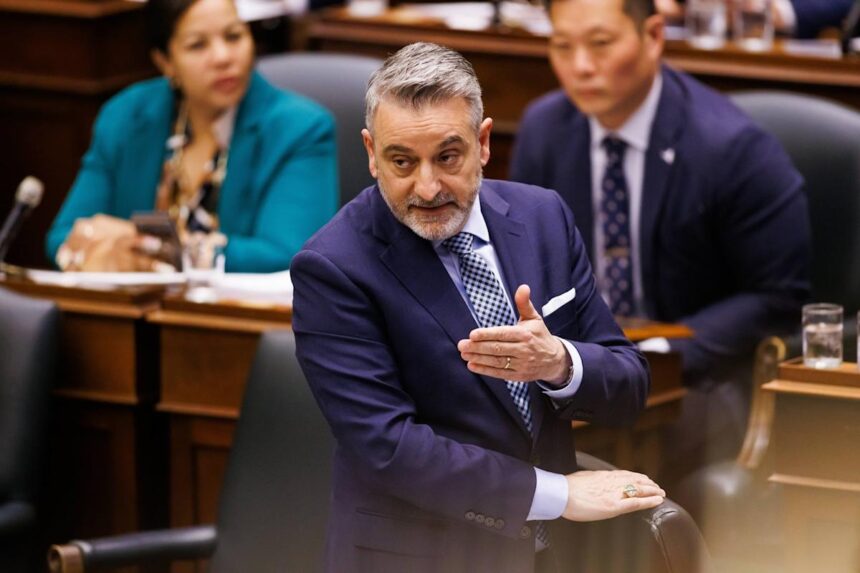The quiet expansion of Ontario’s education minister powers represents a significant shift in how our schools are governed – one that’s drawn criticism from both opposition parties and education advocates alike.
Last week, Education Minister Stephen Lecce gained new authority to issue binding directives to school boards across the province, a move the Ford government describes as necessary to ensure accountability in a system serving more than two million students.
“Parents expect consistency and high standards in their children’s education, regardless of where they live,” Lecce said in a statement to Mediawall.news. “These measures will help ensure all boards are delivering results while maintaining local decision-making.”
The expanded powers, which took effect through regulatory changes rather than legislative debate, allow the minister to issue binding directives on virtually any aspect of board operations – from financial management to curriculum implementation and student achievement.
Walking through the hallways of Riverside Secondary School in Windsor last month, I spoke with principal Maria Gonzalez, who expressed mixed feelings about the change. “We already navigate provincial guidelines alongside local needs,” she explained. “The question is whether these new powers will support that balance or disrupt it.”
The Ontario Public School Boards Association has raised concerns about the timing and scope of these changes. Their president, Cathy Abraham, told me the move “fundamentally alters the relationship between democratically elected trustees and the province” without proper consultation.
The regulatory amendment builds on existing ministerial authority but removes previous limitations that restricted interventions to specific circumstances of financial mismanagement or governance failure. Critics worry this expansion creates a direct line of control from Queen’s Park to every classroom in Ontario.
NDP education critic Chandra Pasma didn’t mince words in her assessment. “This government has consistently undermined public education, and now they’re consolidating power while claiming it’s about accountability,” she said during a press conference at Queen’s Park.
The Ministry points to several situations where intervention was warranted but previously limited by regulatory constraints. A senior ministry official, speaking on background, cited examples including inconsistent implementation of math curriculum and varying approaches to remote learning during the pandemic.
According to the latest Fraser Institute report on Ontario school performance, achievement gaps between boards have widened in recent years, with standardized test scores showing disparities that often align with socioeconomic factors. The government suggests these new powers will help address such inequities.
However, Charles Pascal, former Ontario deputy minister of education and professor at OISE/University of Toronto, sees it differently. “Local governance exists because communities have different needs and contexts,” Pascal explained during our phone conversation. “This centralization of power could potentially homogenize education in ways that harm rather than help students.”
The timing of the change has raised eyebrows, coming just months after several boards pushed back against ministry directives on issues ranging from cell phone policies to gender identity accommodations. The Durham District School Board made headlines last fall when trustees voted to delay implementation of the province’s cell phone ban, citing the need for additional consultation with students and parents.
At Oakwood Community Centre in Toronto’s west end, I attended a parent council meeting where the discussion turned heated over the implications. “We elect our trustees to represent our community’s educational values,” said Jennifer Nguyen, mother of three students in the Toronto District School Board. “If the minister can override them at will, what’s the point of local governance?”
The regulatory change was published with little fanfare in the Ontario Gazette on April 15, yet its potential impact could reshape educational governance for years to come. The timing – during spring break when many education stakeholders were disconnected from policy announcements – has further fueled criticism about transparency.
According to Statistics Canada‘s most recent education indicators, Ontario spends approximately $12,500 per student annually, managing a system that employs over 130,000 teachers across 72 publicly funded school boards. The question now is how this ministerial authority might influence that substantial investment.
Conservative education commentator Doretta Wilson offers a contrasting perspective. “School boards have sometimes become obstacles to implementing improvements,” she told me. “Parents care less about governance structures and more about whether their children are learning effectively.”
The Ontario government has been on a path of increasing centralization in education policy for several years. From mandating remote learning credits to directing specific approaches to mathematics instruction, the trend has been toward provincial standardization rather than local autonomy.
Annie Kidder, executive director of People for Education, sees this latest move as part of that larger pattern. “There’s value in consistent standards,” she acknowledged, “but education is inherently local and responsive to community needs. The concern is whether we’re losing that important dimension.”
As boards digest these changes, the real test will be in how and when the minister chooses to exercise these expanded powers. For students returning to classrooms this spring, the immediate impact may be invisible – but the governance landscape of their education has shifted in ways that could eventually reach every aspect of their school experience.






